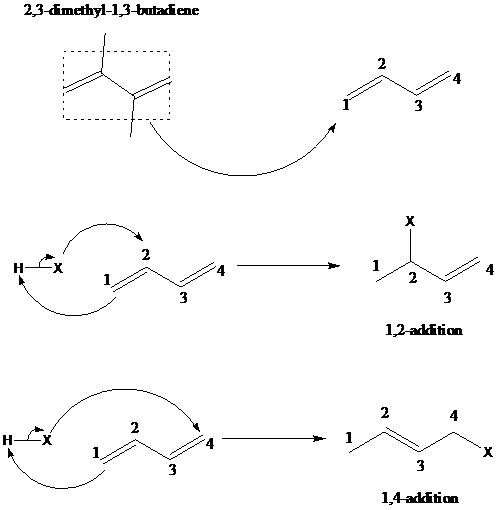
Interpretation:
The mechanism for the given reaction between 2,3-dimethyl-1,3-butadiene and hydrogen bromide is to be determined. The reaction energy coordinate diagram that illustrates kinetic and thermodynamic pathways is to be drawn.
Concept introduction:
舧 Electrophiles are electron-deficient species, which has positive or partially positive charge. Lewis acids are electrophiles, which accept electron pair.
舧 Nucleophiles are electron-rich species, which has negative or partially negative charge. Lewis bases are nucleophiles, which donate electron pair.
舧 Free radical is an atom, molecule, or ion that has an unpaired electron, which makes it highly chemically reactive.
舧 Substitution reaction: A reaction in which one of the hydrogen atoms of a hydrocarbon or a
舧 Elimination reaction: A reaction in which two substituent groups are detached and a double bond is formed is called elimination reaction.
舧 Addition reaction: It is the reaction in which unsaturated bonds are converted to saturated molecules by the addition of molecules.
舧 The reaction in which there is addition of hydrogen molecule is called hydrogenation reaction.
舧
舧 Hydrogenation with platinum as a catalyst is used to convert unsaturated carbohydrates to saturated hydrocarbons
舧 Oxidation of
舧 Ozonolysis helps convert the carbon – carbon double bonds to carbon – oxygen double bond (carbonyl compounds).
舧 Dimethyl sulfide is used as a reducing agent that decomposes the intermediate formed into the carbonyl group.
舧 NBS (nitro-bromo succinimide) is a special reagent used for bromination of allylic carbocations.
舧 Bromine replaces the hydrogen attached to the carbon adjacent to the carbon bearing double bond.
舧 This method of using NBS can produce allylic bromides without bromine reacting with the double bond.
舧 Dehydration of a primary alcohol in the presence of a mineral acid like concentrated sulfuric acid results in the formation of alkene via E2 elimination.
舧 1,2–addition of hydrohalogenation (HX) to a diene is the addition of hydrogen to the carbon designated as 1 and halogen to the carbon designated as 2. The positions of carbon as 1 and 2 are not according to the IUPAC numbering of the molecule, but as a conjugated diene. The mechanism is similar to 1,4-addition. The mechanism of 1,2-addition and 1,4-addition of hydrohalogenation is given below:

舧 When conjugated diene is attacked by an electrophile, the resultant products are formed via 1,2-addition and 1,4-addition reaction mechanism. Kinetics and
Want to see the full answer?
Check out a sample textbook solution
Chapter 13 Solutions
Organic Chemistry
- Provide mechanisms for the two reactions.arrow_forwardPropose a mechanism for the following reaction, an important step in the laboratory synthesis of proteins:arrow_forwardThe following molecule undergoes an intramolecular reaction in the presence of pyrrolidinium acetate, the protonated form of pyrrolidine. Draw the product of this reaction, assuming that a dehydration reaction takes place.arrow_forward
- Nonconjugated , -unsaturated ketones, such as 3-cyclohexenone, are in an acid-catalyzed equilibrium with their conjugated , -unsaturated isomers. Propose a mechanism for this isomerization.arrow_forward10) Consider the following alkene hydration reaction. он H2SO, H20 Given that the reaction is endergonic by 10 kcal/mol, complete the following. (a) Draw the intermediate(s) formed in the mechanistic pathway to the major product in the indicated space below. If there are multiple intermediates label them 1, 2, 3, 4, etc. (b) Sketch a reaction-energy profile for this reaction and clearly label staring material, product, intermediate(s), transition state(s), AG" and AG (of the rate determining step) on your plot. Progress of the reaction Draw and Label Intermediate(s) Below: Potential energyarrow_forwardIdentify the electrophile and the nucleophile in each of the following reaction steps and then draw curved arrows to illustrate the bond-making and bondbreaking processes.arrow_forward
- ) Provide a reaction mechanism for the following reactions and name the major product for each. HBr H,SO4 HO,arrow_forwardKindly trace the arrow movement of its reaction mechanism thank youarrow_forwardPredict the product, draw the mechanism, and plot the reaction coordinate diagram for the Sw1 reaction. میل MeOHarrow_forward
- Suggest a suitable mechanism for this multi-step reaction, and give products A and Barrow_forwardProvide the mechanism for the following reaction (1) PhMgBr (2 equiv) (2) H3O+ workup OHarrow_forwardb) Listed below are several hypothetical nucleophilic substitution reactions. None is synthetically useful because the product indicated is not formed at an appreciable rate. In each case provide an explanation for the failure of the reaction to take place as indicated. OMe HO + OMe + OH HO + CH; OHarrow_forward

 Organic ChemistryChemistryISBN:9781305580350Author:William H. Brown, Brent L. Iverson, Eric Anslyn, Christopher S. FootePublisher:Cengage Learning
Organic ChemistryChemistryISBN:9781305580350Author:William H. Brown, Brent L. Iverson, Eric Anslyn, Christopher S. FootePublisher:Cengage Learning Organic Chemistry: A Guided InquiryChemistryISBN:9780618974122Author:Andrei StraumanisPublisher:Cengage Learning
Organic Chemistry: A Guided InquiryChemistryISBN:9780618974122Author:Andrei StraumanisPublisher:Cengage Learning


